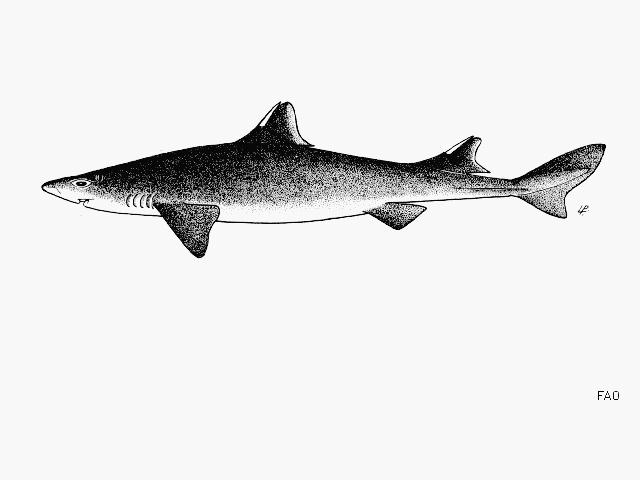Cirrhigaleus asper
(Merrett, 1973)
Roughskin spurdog
Classification: Elasmobranchii Squaliformes Squalidae
Reference of the original description
A new shark of the genus Squalus (Squalidae: Squaloidea) from the equatorial western Indian Ocean; with notes on Squalus blainvillei. Journal of Zoology, 171(1), 93–110
A new shark of the genus Squalus (Squalidae: Squaloidea) from the equatorial western Indian Ocean; with notes on Squalus blainvillei. Journal of Zoology, 171(1), 93–110
Synonyms / new combinations and misspellings
Squalus asper
Squalus asper
Types
Cirrhigaleus asper
Holotype: BMNH: 1972.10.10.1; Paratype: BMNH: 1972.10.10.4; BMNH: 1972.10.10.2; BMNH: 1972.10.10.3;
Cirrhigaleus asper
Holotype: BMNH: 1972.10.10.1; Paratype: BMNH: 1972.10.10.4; BMNH: 1972.10.10.2; BMNH: 1972.10.10.3;
Description :
Citation: Cirrhigaleus asper (Merrett, 1973): In: Database of modern sharks, rays and chimaeras, www.shark-references.com, World Wide Web electronic publication, Version 12/2025
Please send your images of "Cirrhigaleus asper" to info@shark-references.com

Cirrhigaleus asper (Merrett, 1973), © FAO, www.fish-base.org

Cirrhigaleus asper (Merrett, 1973), © FAO, www.fish-base.org
Common names
 Galludo raspa,
Galludo raspa,  Aiguillat à peau rugueuse,
Aiguillat à peau rugueuse,  Roughskin Dogfish,
Roughskin Dogfish,  Roughskin dogshark,
Roughskin dogshark,  Roughskin spiny dogfish,
Roughskin spiny dogfish,  Roughskin spurdog,
Roughskin spurdog,  Quelme rugoso
Quelme rugoso
 Galludo raspa,
Galludo raspa,  Aiguillat à peau rugueuse,
Aiguillat à peau rugueuse,  Roughskin Dogfish,
Roughskin Dogfish,  Roughskin dogshark,
Roughskin dogshark,  Roughskin spiny dogfish,
Roughskin spiny dogfish,  Roughskin spurdog,
Roughskin spurdog,  Quelme rugoso
Quelme rugoso
Short Description
A heavy-bodied dogfish with a blunt, rounded snout, large denticles and noticeably rough skin; body without spots; 1st dorsal fin spine behind pectoral fins [536]. Dark grey or brown above, lighter below; white edges on fins [536]; juveniles brown (Ref. 6577).
A heavy-bodied dogfish with a blunt, rounded snout, large denticles and noticeably rough skin; body without spots; 1st dorsal fin spine behind pectoral fins [536]. Dark grey or brown above, lighter below; white edges on fins [536]; juveniles brown (Ref. 6577).
Distribution
Western Atlantic: North Carolina to the Florida Keys (Ref. 3814) and the northern Gulf of Mexico. Western Indian Ocean: southern Mozambique to South Africa; also Reunion, Comoros, and the Aldabra islands [20041]. Eastern Central Pacific: Hawaiian Islands.
First record: 2019: off Venezuela [27305] Source: www.gbif.org
Western Atlantic: North Carolina to the Florida Keys (Ref. 3814) and the northern Gulf of Mexico. Western Indian Ocean: southern Mozambique to South Africa; also Reunion, Comoros, and the Aldabra islands [20041]. Eastern Central Pacific: Hawaiian Islands.
First record: 2019: off Venezuela [27305] Source: www.gbif.org
Human uses
fisheries: of no interest
fisheries: of no interest
Biology
Ovoviviparous, with 21 to 22 young in a litter. Found on the upper continental and insular slopes [518]. Feeds on bony fishes and squids (Ref. 5213).
Ovoviviparous, with 21 to 22 young in a litter. Found on the upper continental and insular slopes [518]. Feeds on bony fishes and squids (Ref. 5213).
Remarks
shark-references Species-ID=1465;
shark-references Species-ID=1465;
















